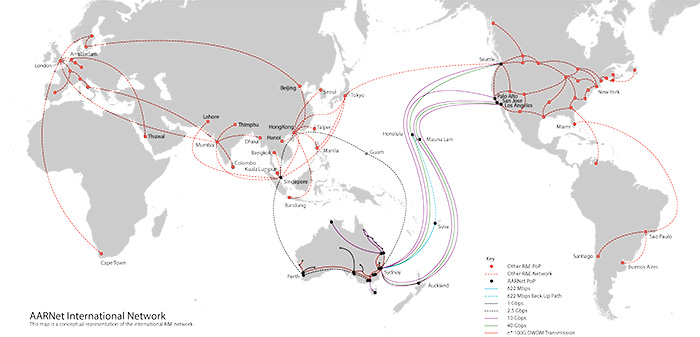Pacific Research Platform Expands Across Pacific Ocean
San Diego and Melbourne, Aug. 6, 2015 — Barely days after announcing the $5 million, five-year NSF-funded Pacific Research Platform (PRP) project led by Calit2 director Larry Smarr, Smarr was in Australia where he signed an agreement with Australia's Academic and Research Network (AARNet) to link Australian researchers to PRP.

The agreement is with the California Institute for Telecommunications and Information Technology (Calit2), on a partnership to connect Australian researchers to the PRP, a ‘next generation data sharing network linking research universities and supercomputing centres at unprecedented speeds.’ The announcement was made during the Australian American Leadership Dialogue meeting being held in Melbourne this week. Founder Phil Scanlan says the announcement is a great example of the kinds of partnerships fostered by the Leadership Dialogue.

AARNet CEO Chris Hancock says Australia and the U.S. have both made major investments in networks based on the Science DMZ architecture over the past few years to support the exponential growth in data-intensive research. “What we are aiming to do now is to connect those networks into a common Australian/ American platform – the Pacific Research Platform – which will support enhanced collaboration by our top researchers in disciplines of critical importance to the future of both our countries,” said Hancock.
Australian research projects in data-centric fields such as particle physics, astronomy, biomedicine, earth science and visualization are set to benefit from the new data-sharing platform connecting them to their American counterparts. They will also be able to share, use and reuse significant collections of data now stored on infrastructure created under the NCRIS RDSI project, using innovative digital tools and techniques.
The partnership is available to any Australian university undertaking Big Data research with PRP institutions. Universities already involved include:
- Institute for Marine and Antarctica Studies at the University of Tasmania (UTAS), together with the UTAS-led Integrated Marine Observing System (IMOS) and Southern Ocean Observing System (SOOS) data groups exchange large oceanographic and geoscience datasets with UC San Diego’s Scripps Institution of Oceanography;
- Monash University: Linking the CAVE2 virtual-reality facility to similar facilities in Hawaii, San Diego and Chicago; and the
- University of Queensland: The university's advanced middleware can connect compute and storage clouds with U.S. to support biomedical, geosciences and imaging data analysis.

“To accelerate the rate of scientific discovery, researchers must get the data they need, where they need it, and when they need it," said UC San Diego computer science and engineering professor Larry Smarr, principal investigator of the PRP and Calit2 director, who is an American delegate to the Leadership Dialogue.. "It is critical that we collaborate globally to develop a common network architecture to support data-intensive research into the future.”
Building on a series of investments to create on-campus Big Data freeway systems, the U.S. National Science Foundation (NSF) last week announced funding for the PRP project. Calit2 and the Center for Information Technology Research in the Interest of Society (CITRIS), led by UC Berkeley, will organize PRP, utilising California’s Corporation for Education Network Initiatives in California (CENIC)/Pacific Wave’s 100G backbone. PRP links most of the research universities on the US west coast.
In parallel with the U.S. effort over the last few years, Australia has funded a similar set of data-centric sites, which are interconnected by the RDSI-funded national Data Sharing Network (DaShNet) implemented and operated by AARNet.
AARNet's Hancock says participating in the PRP project as an international partner was a logical next step. By extending DaShNet, AARNet can interconnect an increasing number of huge research datasets, as well as NCRIS-supported computational resources such as the NCI, Pawsey Centre and the NeCTAR Research Cloud to the PRP networked data infrastructure.
AARNet will provide connectivity to the PRP in partnership with Southern Cross Cable Network via the submarine optical-fiber links known as SXTransPORT to the West Coast of the U.S. and on to San Diego and Calit2 via Pacific Wave and CENIC. With the support of SCCN, AARNet is upgrading SXTransPORT to 100 Gigabits per second by the end of 2016.
“This is another plank in Australia’s platform for sustained high community performance through 2050 and well beyond,” said Leadership Dialogue founder Phil Scanlan.
Related Links
Pacific Network Platform Announcement
Media Contacts
Doug Ramsey, (858) 822-5825, dramsey@ucsd.edu
